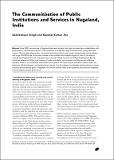| dc.contributor.author | Singh, Kamleshwar | en |
| dc.contributor.author | Jha, Kaushal Kumar | en |
| dc.date.accessioned | 2016-01-27T13:42:06Z | |
| dc.date.available | 2016-01-27T13:42:06Z | |
| dc.date.issued | 01/11/2009 | en |
| dc.identifier.citation | Singh, K. and Jha, K., K. (2009) The of Public Institutions and Services in Nagaland, India. IDS Bulletin 40(6): 31-40 | en |
| dc.identifier.issn | 1759-5436 | en |
| dc.identifier.uri | https://opendocs.ids.ac.uk/opendocs/handle/20.500.12413/8073 | |
| dc.description.abstract | Since 2001, communities in Nagaland have been brought into direct partnerships as stakeholders with government in local service provision. Communitisation is backed by a legal framework and strong state?level support. This has taken place within a context of enduring conflict, social unrest, limited public service delivery and a high HIV/AIDS rate in the state, located in the troubled north?eastern region of India. It has directly involved the Nagaland form of local governance, through Village Councils and Village Development Boards, which are believed to follow local customs of wide consultation and consensus?building around collective concerns. These in turn constitute committees which govern four local services: education, health, water and electricity. While evidence is only beginning to emerge, it so far suggests considerable positive impacts in terms of public service delivery gains in Nagaland. This article outlines some of the questions and issues the Nagaland Communitisation account gives rise to. | en |
| dc.format.extent | 10 | en |
| dc.publisher | Blackwell Publishing Ltd | en |
| dc.relation.ispartofseries | IDS Bulletin Vol. 40 Nos. 6 | en |
| dc.rights.uri | http://www.ids.ac.uk/files/dmfile/IDSOpenDocsStandardTermsOfUse.pdf | en |
| dc.title | The of Public Institutions and Services in Nagaland, India | en |
| dc.type | Article | en |
| dc.rights.holder | © 2009 The Authors. Journal compilation © Institute of Development Studies | en |
| dc.identifier.doi | 10.1111/j.1759-5436.2009.00082.x | en |

